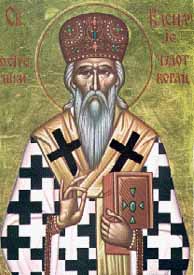Top Qs
Timeline
Chat
Perspective
Basil of Ostrog
Serbian Orthodox bishop and saint From Wikipedia, the free encyclopedia
Remove ads
Basil of Ostrog (Serbian: Свети Василије Острошки, romanized: Sveti Vasilije Ostroški, pronounced [sʋê:ti ʋǎsiːlije ǒstroʃki]; 28 December 1610 – 29 April 1671), also known as Vasilije,[1] was a Serbian Orthodox bishop of Zahumlje who is venerated as a saint in the Eastern Orthodox Church.
Remove ads
Life
Summarize
Perspective
Early life
Stojan Jovanović (Serbian Cyrillic: Стојан Јовановић) was born on 28 December 1610, in the village of Mrkonjići at the Popovo field in the Ljubinje nahija (Herzegovina), at the time part of the Ottoman Empire. His father was Petar Stojanović and his mother was Ana. Legends about him describe him as a diligent and obedient child, saying he inherited his graciousness and benevolence from his parents.
Having raised cattle on the Herzegovinian hills and mountain slopes, he shared all of his food with poorer people. The Ottomans started to notice him and his parents took him to the nearby Zavala Monastery, where his paternal uncle, the hieromonk Serafim served as the hegumen of the monastery. There, he would study and be protected.[2]

Studies
At that time, the monastery had a large library at the monastery church of the Presentation of the Blessed Virgin Mary. He quickly became a master of the Bible and basic Christian mysteries. After a while, his uncle sent him to the Monastery of the Most Holy Mother of God, the Tvrdoš Monastery in Trebinje, for further spiritual and theological studies.[2]
Bishop of Zahumlje
St. Basil's modesty made him reluctant to occupy high positions. However, his dedication to the Church led to his election as Bishop of Zahumlje and Skenderija in 1639. He retired from the position in 1649.
Remove ads
Legacy
Summarize
Perspective

After his death in 1671, he was buried at the Ostrog Monastery which he had founded in Montenegro. His tomb in a cave-church soon became a site of pilgrimage for Christians (both Orthodox and Roman Catholic) and Muslims who were drawn by reports of miracles occurring through the intercession of the saint. The Monastery is now one of the major pilgrimage sites in the Balkans, and large numbers of pilgrims gather, particularly at Pentecost. St. Basil of Ostrog is commemorated in the Serbian orthodox liturgical calendar on April 29 (May 12 in the Gregorian Calendar).[3]
In Montenegro, St. Basil of Ostrog is considered as one of the highest saints. Some Eastern Orthodox priests in Montenegro joke that Montenegrins would pray to Saint Basil before God. The respect given to Saint Basil was also demonstrated during the 2019–2020 clerical protests in Montenegro, during which protestors carried icons of Saint Basil. Significant protests were held around the Church of St. Basil in Nikšić.[4] Some have even credited the veneration of Saint Basil with those protests and the political upheaval that followed. Following the 2020 Montenegrin parliamentary election, Zdravko Krivokapić, leader of the opposition, mentioned Saint Basil in his victory speech, saying that it was the expected result for "those who strike against God and Saint Basil of Ostrog."[5]
The Orthodox seminary in East Sarajevo (Pravoslavni bogoslovski fakultet Sveti Vasilije Ostroški), part of the University of East Sarajevo, is named after him.
A church in Nalježići, in the Grbalj region is also named after him.
Vladimir Kecmanović wrote the poem Ognjen i kelija (2024), inspired by the life of Basil of Ostrog.[6]
Remove ads
See also
References
External links
Wikiwand - on
Seamless Wikipedia browsing. On steroids.
Remove ads

